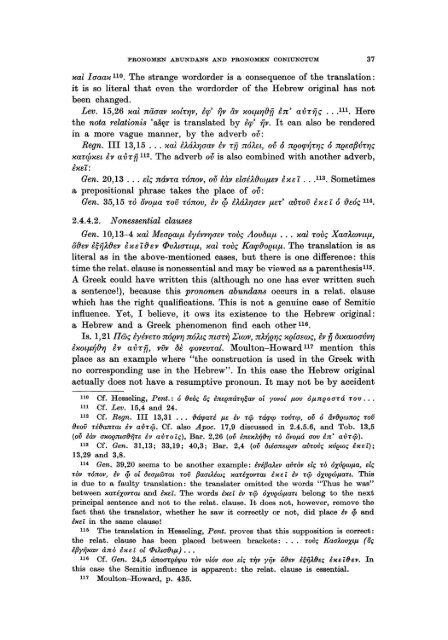Pronomen Abundans and Pronomen Coniunctum. A ... - DWC
Pronomen Abundans and Pronomen Coniunctum. A ... - DWC
Pronomen Abundans and Pronomen Coniunctum. A ... - DWC
You also want an ePaper? Increase the reach of your titles
YUMPU automatically turns print PDFs into web optimized ePapers that Google loves.
PRONOMEN ABUNDANS AND PRONOMEN CONIUNCTUM 37<br />
~al I aaa~ 110. The strange wordorder is a consequence of the translation :<br />
it is so literal that even the word order of the Hebrew original has not<br />
been changed.<br />
Lev. 15,26 ~al :rtiiaav ~otT'YJv, üp' ijv av xotp:YJ{}fi h,' aii'rnç ... m. Here<br />
the nota relationis 'as~r is translated by èq;' ifv. It can also be rendered<br />
in a more vague manner, by the adverb ov:<br />
Regn. III 13,15 ... ~al è)..á),'Yjaav èv Tfi nó),ct, ov Ó n(!oqJ'I}T'YjÇ Ó n(!eafJvT'Yjç<br />
xaT(!>~et èv a'ÎJ'rfj 112. The adverb ov is also combined with another adverb,<br />
è~ei:<br />
Gen. 20,13 ... elç návTa Tónov, ov èàv elai).{}wf-lev èxel . . . 113. Sometimes<br />
a prepositional phrase takes the pI ace of ov:<br />
Gen. 35,15 Tà övof-la TOV Tónov, èv i[> è)'áA'Yjaev f-leT' aVTov è~e'i ó {}eóç 114.<br />
2.4.4.2. N onessential clauses<br />
Gen. 10,13-4 xal Mea(!atf-l èyévv'Yjaev TOVÇ Aovbllf-l •.. xal TOVÇ XaaAwvllf-l,<br />
ö{}ev è$n),{}ev èxe'{{}ev rfJvAtaTllf-l, ~al TOVÇ Kacp{)O(!llf-l. The translation is as<br />
Iiteral as in the above-mentioned cases, but there is one difference: this<br />
time the relat. clause is nonessential <strong>and</strong> may be viewed as a parenthesis l15 .<br />
A Greek could have written this (although no one has ever written such<br />
asentence!), because this pronomen abundans occurs in arelat. clause<br />
which has the right qualifications. This is not a genuine case of Semi tic<br />
influence. Yet, I believe, it ows its existence to the Hebrew original:<br />
a Hebrew <strong>and</strong> a Greek phenomenon find each other 116.<br />
Is. 1,21 llwç èyéveTo nó(!v'Yj nÓAtç ntaTi} Etwv, nUJ(!'Yjç ~(!{aswç, èv ij btxawaVv'Yj<br />
èxotf-l~fJ'Yj èv aVTfj, vVv bi cpovevm{. Moulton-Howard 117 mention this<br />
pI ace as an example where "the construction is used in the Greek with<br />
no corresponding use in the Hebrew". In this case the Hebrew original<br />
actually does not have a resumptive pronoun. It may not be by accident<br />
llO Cf. Hesseling, Pent.: ó fJeoç öç ÈnE(lnáTT};av ol yovot P.OV op.n(loaTá TOV •••<br />
111 Cf. Lev. 15,4 <strong>and</strong> 24.<br />
112 Cf. Regn. III 13,31 ... {}áljJaTÉ P.E È'v Tep TátpqJ TOtTrqJ, ov ó èiv{}(lwnoç TOV<br />
{}EOV Ti{}anTat Èv aVTep. Cf. also Apoc. 17,9 discussed in 2.4.5.6, <strong>and</strong> Tob. 13,5<br />
(ov Èàv al(O(lntafHjTE Èv aVToiç), Bar. 2,26 (ov ÈnEI().f){}T} TO ovop.á aov Èn' aVTep).<br />
ll3 Cf. Gen. 31,13; 33,19; 40,3; Bar. 2,4 (ov &ÉanEt(lEV aVTovç I(V(lWç ÈI(Ei);<br />
13,29 <strong>and</strong> 3,8.<br />
114 Gen. 39,20 seems to be another example: ÈvÉ{3a).EV aVTov tlç TO oxv(lwp.a, Elç<br />
TOV Tónov, Èv
















